More Zendikar Rising Stars
Last week, I started telling some card-by-card design stories about Zendikar Rising. I had more stories to tell, so I'll continue this week.
Jace, Mirror Mage and Nissa of Shadowed Boughs
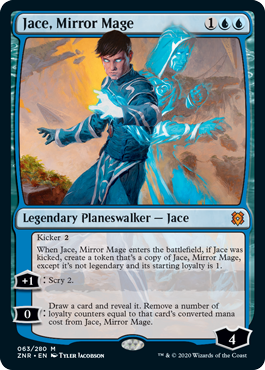
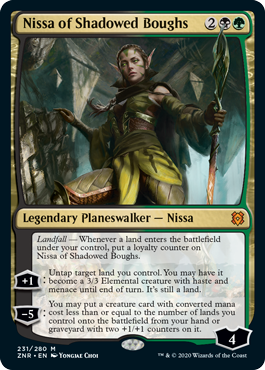
When we first made the planeswalker card type, we wanted to create a sense that the planeswalkers were a bit disconnected from the set in which they appeared. We felt it gave them a feeling of being bigger than just that world. Also, in many cases, the planeswalker wasn't even from that plane and the disconnect helped play up that fact. As such, we made a rule for ourselves that we wouldn't use set-specific mechanics (anything non-evergreen) on planeswalker cards. We knew we might make the occasional exception for a strong story or flavor reason, but in general, we wouldn't cross the streams of worldbuilding and planeswalker building.
What follows was many years of us designing planeswalker cards. What started as a card type we thought we'd do on occasion (yes, the original plan was that they would show up in maybe one set a year) ended up becoming a player favorite that we put in every set. The more we designed them, the more we realized something important—planeswalker design space is a lot smaller than you might think at first blush. This is problematic for a card type with as much fanfare as planeswalkers. This has led to us making a number of changes to our philosophy, including the idea of not using set-specific mechanics. In fact, I feel we've now gone to the other end of the spectrum where we see set-specific mechanics as a way to make the planeswalkers feel more connected to the set and open up more design space.
That is why two of our three planeswalkers in Zendikar Rising use set-specific mechanics. Landfall seemed like a flavorful connection to Nissa, who bonds with the land, and kicker ended up being a cool way to execute on the illusion trope of Jace. What does this mean for the future of planeswalkers? Expect to see this trend continue. (And to be fair, it didn't start here—this is something we've been ramping up over time; this just seemed like a good spot to acknowledge it.)
Lotus Cobra

I don't think any card resulted in more arguments in R&D during original Zendikar than this card. It got created easily enough. We were designing landfall cards in design (what would have been the vision design portion of the design in today's model) and were looking for cool effects to use with it. "Add one mana of any color" seemed simple, yet exciting. It got stuck in the file as a rare, and I was pretty confident that it was going to stay there all the way to print.
Flash forward many months, close to the end of the set's development (what would be play design nowadays). The card had played great and was seeing a lot of use in our FFL (Future Future League—what R&D uses to playtest future environments). The decision was made to move it from rare to mythic rare with the idea being that it was exciting enough (and had enough potential to do cool things) to be a mythic rare.
The mythic rare rarity had just started the year before in Shards of Alara. I'd written the article about it and had spent a lot of time laying out a general philosophy of how we were planning to treat the mythic rare rarity. I didn't personally think that Lotus Cobra fit the philosophy I'd laid out. That said, the mythic rare rarity was a new thing and R&D was still trying to let it evolve as we better understood it in the context of new cards and new sets. R&D was split down the middle between the rare camp and the mythic rare camp. For the next couple months, there were many arguments, but in the end, there wasn't a better choice to replace it with, so it stayed a mythic rare. My one suggestion, once it was determined that the rarity shift was not changing, was to switch the name to Lotus Cobra. If it was going to be mythic rare, it at least deserved to have a name that sounded mythic. (Longtime readers know I'm a big believer in "power" words—aka words that excite players because they're associated with powerful cards.)
Original Zendikar came out, and many players both loved Lotus Cobra and believed it should be rare, not mythic rare. In my role as spokesperson and frequent audience interactor, I had to spend a lot of time explaining why it was mythic rare. One of the odd parts of my job is that I'll fight so hard for something behind the scenes, but then have to defend what we did once the product comes out even if it's the thing I fought so hard against.
So, flash forward again, this time many years, and we're designing Zendikar Rising. We'd brought back landfall during our first return in Battle for Zendikar, but we were much more conservative about how powerful we were making it, so Lotus Cobra was off the table as a reprint. In Zendikar Rising, Erik (Lauer—the lead set designer) felt we could be a bit more aggressive than we'd been in Battle for Zendikar, and that meant that Lotus Cobra was possibly on the table again as a reprint. I'm not only happy to see it back, I'm also happy to see it at the rarity which I'd originally wanted it. I hope that I get a lot less mail.
Molten Blast
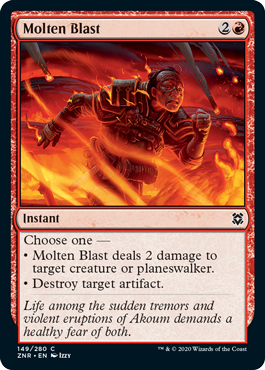
Molten Blast is a good chance for me to talk about another shift R&D has made over the last few years—how we handle niche effects. What I mean by that is how do we make cards that do things that you don't need a good amount of the time? For most of Magic's life, we treated these cards as "sideboard cards." That is, these were cards that you wouldn't play main deck (except maybe to offset a warped metagame), but you would pull into your deck between games. I should note that "sideboarding" also happens in more casual "kitchen table" Magic, but more unofficially. Your friend keeps beating you, so you change your deck to better deal with it. That often involves these sideboard cards.
The shift has been to find ways to get these cards into the main deck so they're there when you might need them. (And yes, the increase in Best-of-One play on Magic: The Gathering Arena has contributed to this, although it's one of multiple influences.) The most popular way to do this is how Molten Blast does it—the increase of modes. Yes, the spell does do this narrower effect (like artifact destruction), but it also has another effect (or effects) that is generally more useful. In Molten Blast's case, that's direct damage. The idea is that you put Molten Blast in your deck as a means of creature and planeswalker removal, but if an artifact starts causing you problems, you have access to an artifact-destruction effect. Expect this trend to continue.
Snap-On Equipment Cycle
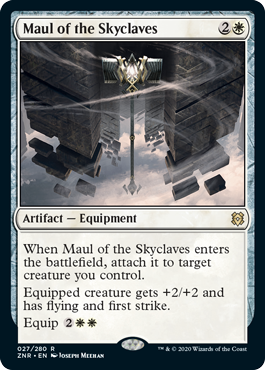

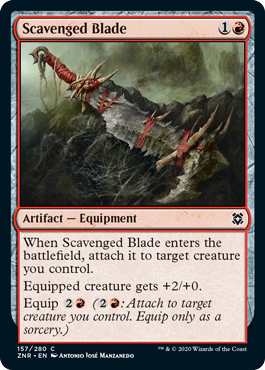

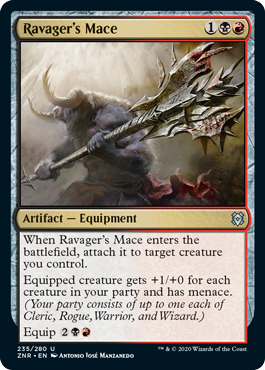
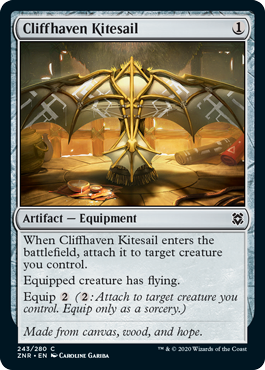
You might notice that all the equipment in Zendikar Rising snaps on when it enters the battlefield. Why exactly is that? There are a number of answers. First up, Zendikar Rising needed to support each of the four class creature types used in the party mechanic. One of those is Warrior. What defines a Warrior? Well, they're good at fighting. In vision design, we explored various ways to help them in combat. One of those ways was making them better with equipment. It's very flavorful that Warriors are good with weapons, and in Magic, most equipment is flavored as a weapon. Having the weapons snap on makes it easier to balance them, as it provides a more consistent experience from game to game.
Second, it really helps fill in the midgame. Zendikar Rising has landfall for the early game and kicker for the late game. Snap-on equipment helps you have stuff to do in between. Third, it, along with higher equip costs, allows the cards to have a different functionality as the game progresses. They act more like Auras early game, allowing them to be relevant faster, but have the ability to move around late game, playing up their flexibility. Four, I think Erik just really likes snap-on equipment. When the set was handed off to the Set Design team, Erik made the decision to change all the equipment to snap on almost immediately as he recognized all the reasons I stated above.
Tazeem Raptor, Confounding Conundrum, Into the Roil, Pyroclastic Hellion, Wayward Guide-Beast, Kazandu Stomper, Nissa's Zendikon, and Murasa Rootgrazer
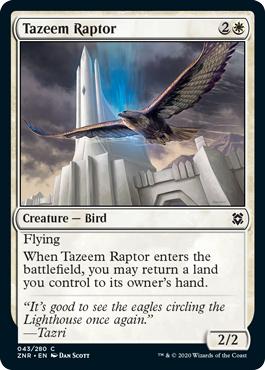

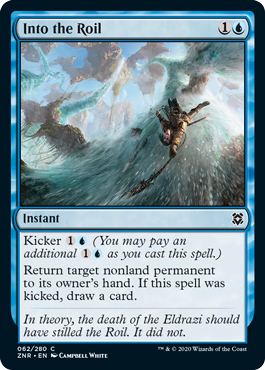
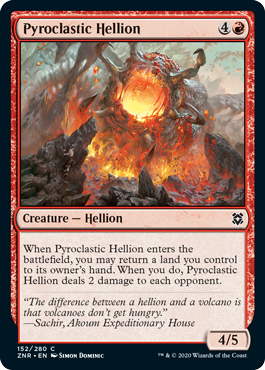
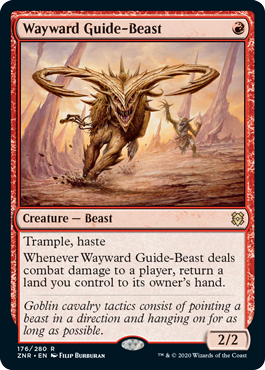
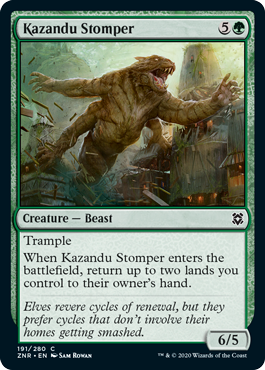
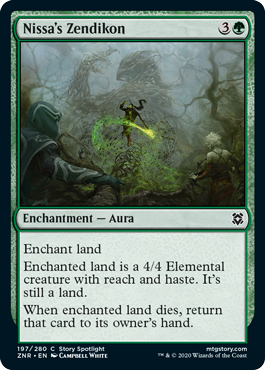
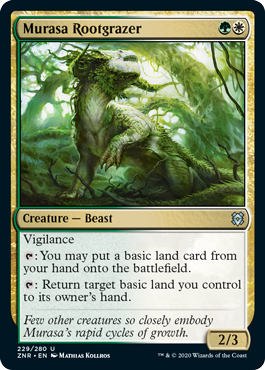
Whenever you introduce a new mechanic, one of the things you want to do is figure out what basic effects of Magic are synergistic with this new mechanic and then you want to raise the volume of that thing or things in the set. Well, one of the new mechanics in Zendikar Rising is the modal double-faced cards (MDFCs). These are double-faced cards where you are able to choose which side you play or cast. What basic effect would synergize with that?
The key to cracking this is to first identify what the commonality is between all the cards in the set with the new mechanic. During vision design, we'll literally write all the aspects on a white board. For Zendikar Rising MDFCs, here's what we got:
- They all have two faces
- Each side has its own name and rules text (and art, but black-border Magic can't care about art mechanically)
- You can play or cast either side
- At least one side is a land
- The lands tap for a single color of mana
All the cards being a land on one side was the thing that jumped out first. We're on Zendikar, the world best known for land mechanics and themes, so there seemed to be synergy there (and obviously, this is why we chose these particular MDFCs for Zendikar Rising). How would you want to interact with the lands? On the battlefield, they're like most other lands. In fact, they're a little more boring than most lands because all they do is tap for one color of mana. What makes them interesting is that they have a back side that's not a normal Magic back. That only means something though when they're in your hand. Okay, is there a way to get land from the battlefield to your hand? There is—what we call land bouncing (aka putting a land on the battlefield back into your hand).
The reason land bouncing is so synergistic is because of how it plays with the ways MDFCs are used in Zendikar Rising. If you need mana in the early game, you're likely to play the MDFCs as their land side. But later in the game when you've drawn other mana, you may no longer need the mana and the other side of the card might be more interesting to you. The problem being that there's no way to change it from one side to the other while it's on the battlefield (these aren't transforming double-faced cards, after all). If you can get it back into your hand, though, that opportunity opens up.
Land bouncing can happen in two major ways. You can bounce it as an effect, or you can bounce it as a cost. Zendikar Rising explores both (although more of the former). Each of the cards above is a card that lets you, through various means, replay your MDFCs as the other side. Also, because landfall is in the set, land bouncing is useful as it lets you play your lands a second time to retrigger landfall, which will often include the MDFCs. (It's the biggest reason you might return a nonland MDFC permanent from your battlefield so that you can play it as a land.)
Soaring Thought-Thief

The "eight or more cards in a graveyard" theme was something that got introduced during set design when they were trying to build out the themes for the Rogue creature type (which also was the blue-black Draft archetype for the set). Traditionally, Rogues tend to play into a saboteur strategy (R&D speak for effects triggered based on dealing combat damage). The Set Design team was trying to find something that felt Rogue-ish but played in some new space. Graveyard threshold was interesting because blue and black do numerous things to help fill up the graveyard (milling, countering, discard, creature kill, etc.). I believe the theme was inspired by Jace's Phantasm from Magic 2013.
I saw the theme for the first time when I was doing a check-in on the set. Part of leading a vision design is checking in downstream from time to time to make sure that the set hasn't deviated from something that was important to the vision. It's very common for themes, like the "eight cards in a graveyard" theme, to get added during set design as Draft archetypes are fleshed out. I did have one note, which was that Magic already had a threshold in the graveyard mechanic (threshold from Odyssey), and if seven and eight were close enough in power level, that it would be better to reuse seven to have some continuity with Magic's past. It turned out that the differential did matter (interestingly, in both Limited and Constructed), and it was kept at eight cards.
Tajuru Paragon, Veteran Adventurer, and Stonework Packbeast
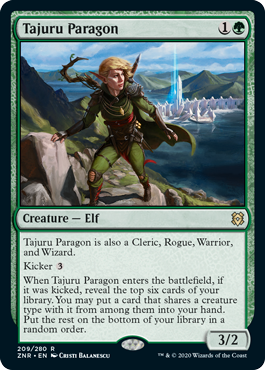

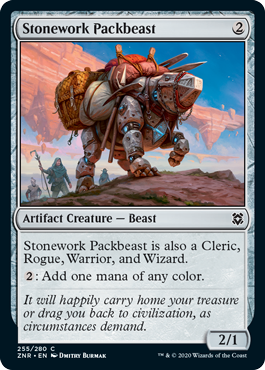
Pretty early on in the creation of the party mechanic, we asked the question, "Are there supposed to be creatures with more than one of the party classes?" For instance, should there be a Rogue Wizard or a Warrior Cleric? It would be easy to do from a flavor perspective, but it was a trickier question about what it did for the mechanic. When you make a mechanic, you want to make sure to give it support, but you also don't want to make it too easy.
We tried a few combo-class creatures (aka creatures with two class creature types) in early vision design and found that it made the party cards a little too hard to cost. You essentially had to cost them as if you had access to the combo-class creatures, which made it very hard to use the cards when you didn't have them in your deck. (This was more of a Limited issue—in Constructed, you would clearly just include them.) When we handed off the file, we didn't have any creatures with more than one of the four classes, but we made a note that it was something the Set Design team might want to explore further.
The way party got divided between the colors (in everything except green, which I will get to in a moment) is that we made each color primary in one of the four classes, secondary in another, tertiary in a third, and absent in a fourth. Green was primary in none of the classes but was the only color where all four showed up. During set design, the team experimented with some "party in one" creatures where the creature had all four relevant classes. The only choices for these "all in one" creatures were green and artifact, as the other four colors were specifically missing one of the classes.
The reason they ended up using them was that it helped in three ways. One, it increased overall support for party drafting. Two, it helped make green more relevant in party decks, as green being primary in none of the class types was preventing the color from adding enough to the decks to warrant using. Three, it was a tool the Play Design team could use to give party a chance at being a Constructed thing. Set Design ended up making three "party in one" creatures. First, a common artifact to give any party deck access to it. The creature helps fix your mana as party decks like to spread out in color. Second, an uncommon green creature, a bit higher up on the curb, to help green party decks in Limited. And third, a rare designed more with an eye on a Constructed party deck.
Zendikar Rise and Shine
Well, that's all the time I have for today. I hope you enjoyed my stories. As always, I'm eager to hear any feedback on the cards I talked about or Zendikar Rising in general. You can email me or contact me through any of my social media accounts (Twitter, Tumblr, Instagram, and TikTok) to let me know what you think.
Join me next week for my Zendikar Rising vision design handoff document.
Until then, may you create new stories with these cards.
#775: Rachel Agnes
#775: Rachel Agnes
31:16
In this podcast, I interview Rachel Agnes, Magic brand manager. What does she do and how did she come to do it? Listen in and find out.
#776: Zendikar Rising
#776: Zendikar Rising
34:57
I tell the story of Zendikar Rising's design.
- Episode 774 Replies with Rachel #5
- Episode 773 Adam Prosak
- Episode 772 Making Magic in the Pandemic

